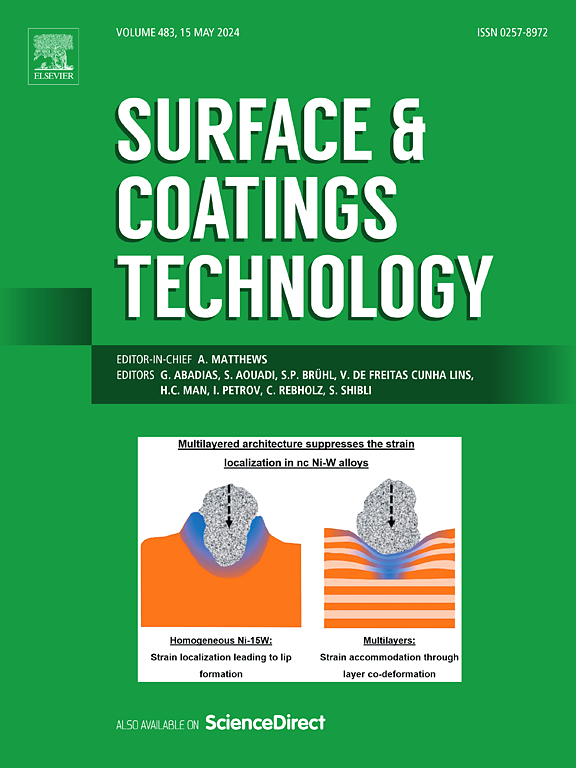Synergistic regulation of hydrogen trapping-diffusion at grain boundaries and interfacial hydrogen resistance in La₂O₃/Y-doped Cr₂O₃-based coatings
IF 5.3
2区 材料科学
Q1 MATERIALS SCIENCE, COATINGS & FILMS
引用次数: 0
Abstract
To mitigate hydrogen embrittlement in hydrogen-transport pipeline steels under prolonged hydrogen exposure, this study optimizes the hydrogen barrier performance of Cr₂O₃-based coatings via plasma spraying and investigates the mechanistic role of La₂O₃/Y doping using first-principles calculations. The Cr₂O₃/La₂O₃ coating delayed hydrogen breakthrough time by 21-fold and reduced steady-state current density by 95.9 %, while the Cr₂O₃/Y coating demonstrated superior performance with a 27-fold delay in breakthrough time and a 97.8 % current density reduction. Mechanistic analysis revealed that La enhances H diffusion barriers at interstitial sites and forms efficient hydrogen traps via oxygen vacancies with ultralow insertion energy, whereas Y achieves dual regulation: interstitial trapping through low-energy sites and vacancy blocking via lattice strain induced by Cr-O/Y-O bond length mismatch. Atomic-scale insights further elucidated how rare-earth oxides (La₂O₃, Y₂O₃) regulate grain boundaries, vacancy defects, and hydrogen diffusion pathways, establishing a synergistic framework for designing high-performance hydrogen barrier coatings. These findings bridge atomic-scale mechanisms to macroscopic performance, offering a theoretical foundation for optimizing anti‑hydrogen coating systems.
La₂O₃/ y掺杂Cr₂O₃基涂层中晶界氢捕获扩散和界面氢阻力的协同调节
为了减轻氢输送管道钢在长时间氢暴露下的氢脆,该研究通过等离子喷涂优化了Cr₂O₃基涂层的氢屏障性能,并利用第一性原理计算研究了La₂O₃/Y掺杂的机理作用。Cr₂O₃/La₂O₃涂层将氢的突破时间延迟了21倍,将稳态电流密度降低了95.9%,而Cr₂O₃/Y涂层表现出更好的性能,突破时间延迟了27倍,电流密度降低了97.8%。机理分析表明,La增强了H在间隙位的扩散屏障,并通过超低插入能的氧空位形成高效的氢阱,而Y实现了双重调控:通过低能位点捕获间隙和通过Cr-O/Y- o键长不匹配引起的晶格应变阻塞空位。原子尺度的见解进一步阐明了稀土氧化物(La₂O₃,Y₂O₃)如何调节晶界,空位缺陷和氢扩散途径,为设计高性能氢障涂层建立了协同框架。这些发现将原子尺度机制与宏观性能联系起来,为优化抗氢涂层体系提供了理论基础。
本文章由计算机程序翻译,如有差异,请以英文原文为准。
求助全文
约1分钟内获得全文
求助全文
来源期刊

Surface & Coatings Technology
工程技术-材料科学:膜
CiteScore
10.00
自引率
11.10%
发文量
921
审稿时长
19 days
期刊介绍:
Surface and Coatings Technology is an international archival journal publishing scientific papers on significant developments in surface and interface engineering to modify and improve the surface properties of materials for protection in demanding contact conditions or aggressive environments, or for enhanced functional performance. Contributions range from original scientific articles concerned with fundamental and applied aspects of research or direct applications of metallic, inorganic, organic and composite coatings, to invited reviews of current technology in specific areas. Papers submitted to this journal are expected to be in line with the following aspects in processes, and properties/performance:
A. Processes: Physical and chemical vapour deposition techniques, thermal and plasma spraying, surface modification by directed energy techniques such as ion, electron and laser beams, thermo-chemical treatment, wet chemical and electrochemical processes such as plating, sol-gel coating, anodization, plasma electrolytic oxidation, etc., but excluding painting.
B. Properties/performance: friction performance, wear resistance (e.g., abrasion, erosion, fretting, etc), corrosion and oxidation resistance, thermal protection, diffusion resistance, hydrophilicity/hydrophobicity, and properties relevant to smart materials behaviour and enhanced multifunctional performance for environmental, energy and medical applications, but excluding device aspects.
 求助内容:
求助内容: 应助结果提醒方式:
应助结果提醒方式:


